Invisalign – Richmond, VA
Keep Your Confidence While You Straighten Your Smile
You’ve always wanted to straighten your teeth, but at this point in your life, you don’t want to wear metal braces for several years to make it happen. We have wonderful news! You can realign your smile without sacrificing your appearance. Made of clear plastic, Invisalign aligners are subtle and practically disappear when worn. As a result, you don’t have to worry about metal brackets and wires interfering with your social and professional interactions. Reach out to one of our two dental offices to straighten your teeth and finally have the smile you’ve dreamed about thanks to Invisalign in Richmond, VA.
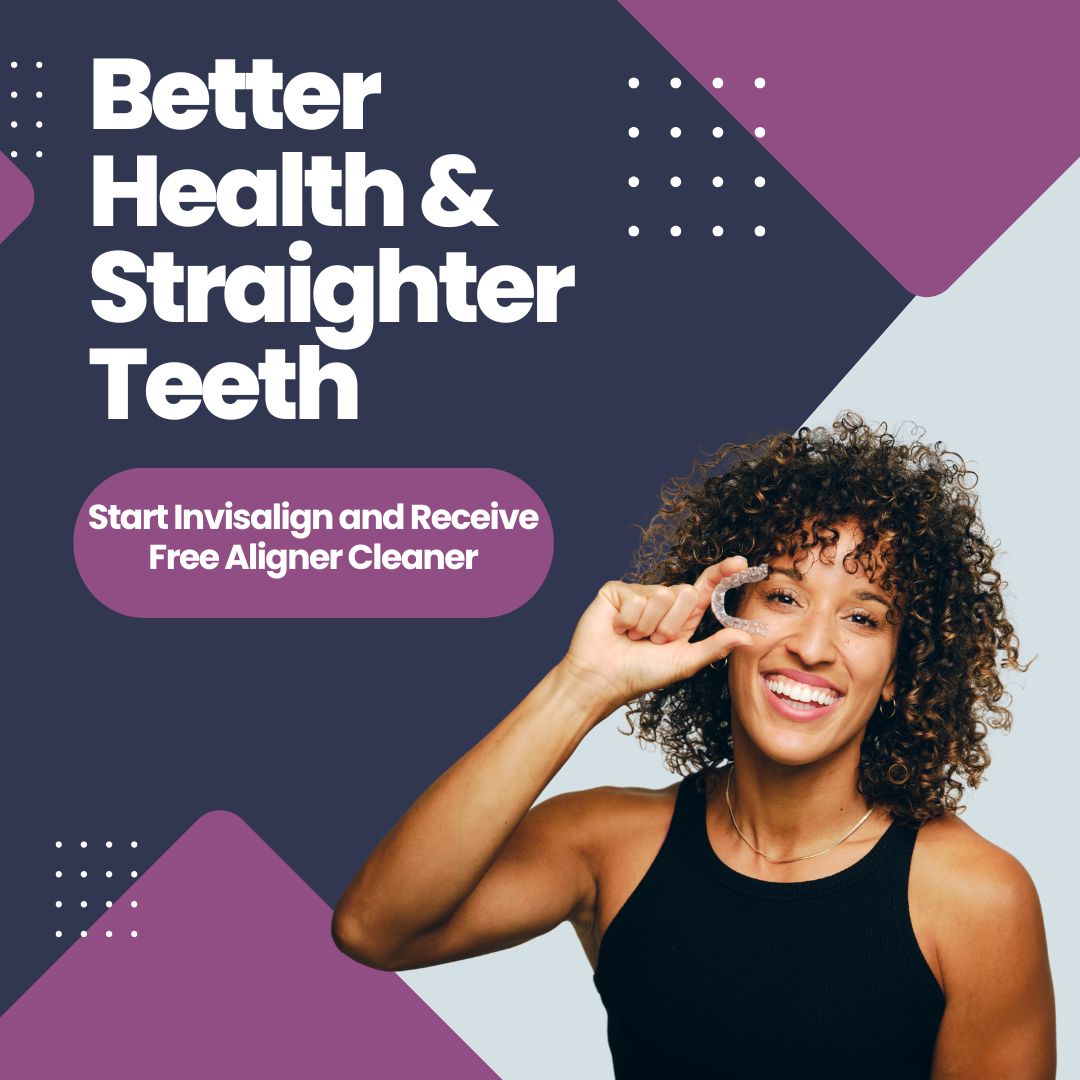
Why Choose Brown, Reynolds, Snow, LeNoir Dentistry for Invisalign?
- Customized Treatment Plan Just for You
- Multiple Dentists with Years of Experience & Training
- Low-Interest Financing with CareCredit Available
Benefits of Invisalign
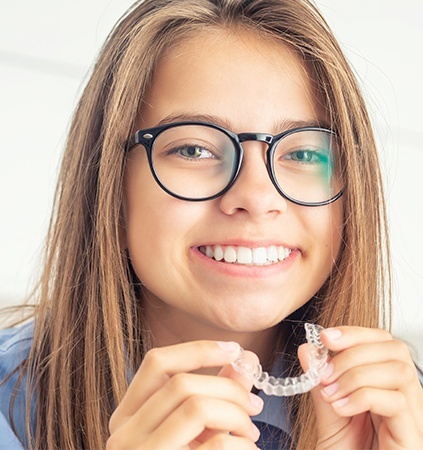
Thanks to significant advancements in both technology and the field of orthodontics, patients today have several options when it comes to straightening their teeth. If you’re currently in the process of choosing between traditional braces and Invisalign, then read on to learn a few of the many advantages of clear aligners!
Discreet Appearance
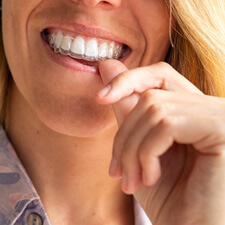
For many patients, the one thing stopping them from pursuing their dream smile is the thought of wearing metal brackets and wires. The good news is that Invisalign is virtually undetectable thanks to the custom-made, low-profile, and see-through aligners. As a result, even the people in your inner circle will have a hard time telling when you are wearing them!
Less Irritation

One of the best parts of Invisalign is that the aligners feel as great as they look. That’s because the plastic is smooth, low-profile, and made to perfectly contour your teeth. This ensures that they feel much nicer on your lips and cheeks than bulky metal brackets. Plus, if you ever need to take them out, you can – they are completely removable!
Faster Average Treatment Timeline

Oftentimes, traditional braces take 24 to 36 months. Invisalign, on the other hand, can typically be completed in 12 to 18 months. At your consultation, we will assess the complexity of your case and determine how many aligners you need in order to provide you with an estimate of your treatment timeline. We’ll also share all of our tips for avoiding frustrating delays!
Easier Maintenance

In order to brush and floss around the brackets and wires, patients with traditional braces often need to adopt cumbersome oral hygiene regimens and buy special oral hygiene products, like interproximal toothbrushes. Conversely, patients with Invisalign can simply remove the aligners and continue their normal oral hygiene routine.
No Food Restrictions

In short, you can eat whatever you want with Invisalign. Just be sure to exercise caution with extremely crunchy foods (i.e., hard pretzels, tortilla chips, raw nuts) since they can result in a chipped tooth or broken attachment. It’s also important to brush and floss before putting the aligners back in, including after lunch or any snacks you have.
Quick Follow-Up Appointments
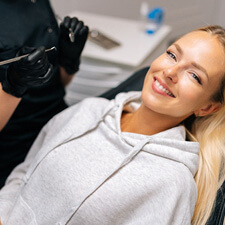
Patients today are busier than ever before. The good news is that if your schedule is jam-packed, it won’t be weighed down further with Invisalign. That’s because the follow-up visits are every 6-8 weeks instead of every 4. Plus, they usually are only 15 minutes or so.
Note: If you lose your aligners or you fall off-track with your treatment plan, then more frequent appointments may be needed. Again, we will do our part to help prevent that from happening by providing you with helpful tips and tricks for how to stay on-track during your teeth-straightening journey.
What Is the Invisalign Process?
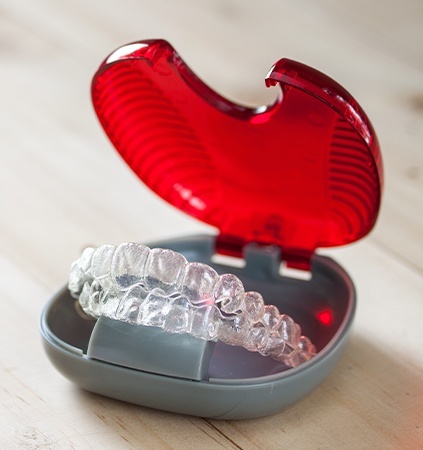
During a consultation with one of our dentists, you can both determine whether Invisalign is a good choice for your smile. At this point, we will take impressions of your teeth and start creating your treatment plan. An Invisalign dental lab will fabricate your aligners accordingly and send out the first few sets. Once they arrive, you’ll wear each set for at least 20 hours every day for about two weeks at a time. Then, you switch to the next set. You’ll need to come into our dental office every once in a while so that we can make sure you’re progressing as planned.
Who Can Invisalign Help?
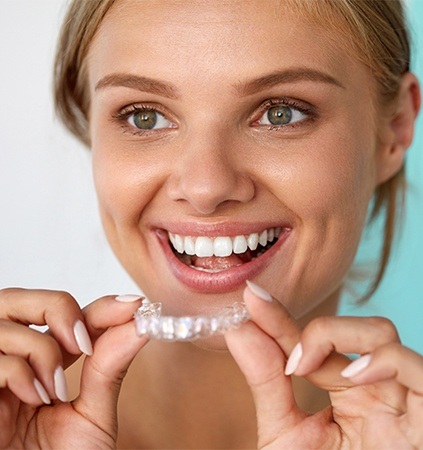
Although many patients qualify for Invisalign treatment, it may not be right for everyone. For example, you need to have only mildly or moderately misaligned teeth; more severe cases may require traditional braces. Additionally, you must be compliant with our instructions; otherwise, you’ll experience delays in treatment, potentially costing you more in the long run. In short, the best way to know whether Invisalign could work for you is to meet with one of our dentists for a more detailed discussion and exam. In the meantime, you can read on to learn more on the topic!
Crowded Teeth
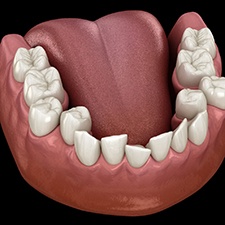
If your teeth crowd together, are rotated, or are tilted out of position, then it’s important to know that the health and function of your smile are at risk. After all, patients with this orthodontic problem are vulnerable to dental problems, like tooth decay, and can experience complications like premature wear and tear on certain teeth. Simply put, straightening your teeth with Invisalign can positively impact the look, health, and function of your smile!
Gaps Between Teeth
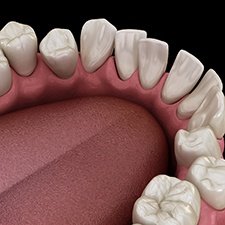
What if your teeth are spaced out instead of crowded together? Unfortunately, this orthodontic problem also poses a risk to your oral health. Plus, many teenagers and adults with considerable gaps between their teeth experience low self-esteem. The good news is that Invisalign clear aligners can carefully, discreetly, and painlessly close the gaps – all in an average of 12-18 months too!
Overbite
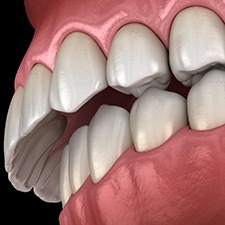
Although you want your upper teeth to sit in front of your lower ones, you don’t want them to jut out far beyond them. This orthodontic problem – known as an overbite – can make it difficult to chew properly and enunciate clearly. It’s also common for chronic jaw pain and premature wear and tear on certain teeth to be a concern, which is why patients are encouraged to come in for a consultation sooner rather than later.
Underbite
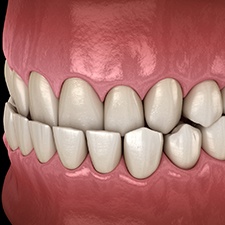
If you have the opposite problem (your lower teeth sit in front of your upper teeth), then it’s important that you schedule a consultation with us so we can determine if you’re a candidate for Invisalign. If you are, then we will get to work creating a custom treatment plan, which may involve additional orthodontic accessories, like rubber bands and buttons. Then, we’ll give you specific instructions on what to do so you can stay on track with your treatment plan!
Crossbite
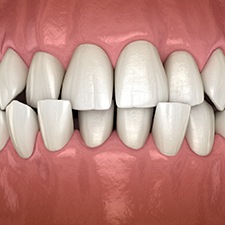
If some – but not all – of your lower teeth sit in front of your upper teeth, then you may have a crossbite. This bite problem can wear down certain teeth since the pressure isn’t evenly distributed, and it can also take a toll on the look and function of your smile. The silver lining is that mild and moderate cases can often be addressed with Invisalign clear aligners!
Open Bite
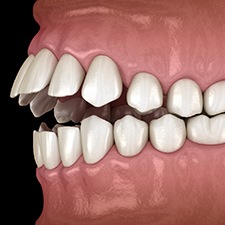
When you bite down, your upper and lower teeth should come together evenly. If they don’t because there is space in the front or back of your mouth, then you might have an open bite. In that case, we recommend having it corrected before problems like chronic jaw pain arise.
Invisalign Teen

If your teen needs braces, but they aren’t particularly thrilled about the idea of wearing metal brackets and wires, it’s worth scheduling a consultation to see if they are a candidate for Invisalign! If they are, then we can improve the look, health, and function of their smile with a series of custom-made aligners that won’t draw any unwanted attention to their smile. Want to learn more on the topic? Read on or give us a call!
How is Invisalign Teen Different?
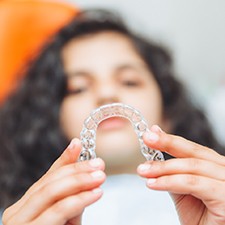
Since the clear aligners look exactly the same, you might be wondering, “What’s the difference?” The first main difference is that the trays have a small blue indicator dot. This gives valuable insight into how well your teen is following the guidelines, like wearing their aligners for 20-22 hours a day. Another key difference is that Invisalign Teen includes a few complimentary replacement trays in case your child accidentally loses one during their teeth-straightening journey.
Is Invisalign Right for Your Teen?
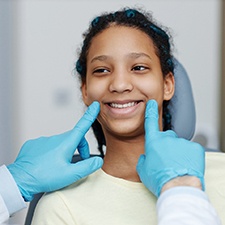
Invisalign usually isn’t ideal for more severe cases of malocclusion; traditional braces are the best choice. This orthodontic treatment also isn’t ideal if your teen is constantly losing their things. Although there are a few replacement trays included, constantly replacing them can get expensive and time-consuming. Ultimately, the decision on whether or not Invisalign is ideal for your child will be a joint decision between you, your child, and their dentist.
The Benefits of Invisalign Teen
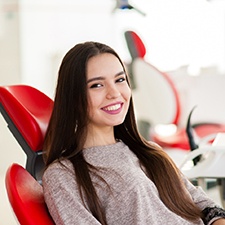
Invisalign Teen offers countless benefits. Here are a few noteworthy ones:
- No Dietary Restrictions: Unlike traditional braces, patients with Invisalign can eat whole apples, raw nuts, tortilla chips, thin-crust pizza, and more! The only “rule” is that foods and drinks with added sugar should be kept to a minimum to help prevent tooth decay.
- Hassle-Free Oral Hygiene: Like many parents, you may have a hard time getting your teen to brush and floss consistently. The good news is that Invisalign won’t make their oral hygiene regimen any more complicated. All they need to do is take their aligners out first!
- Discreet Trays: Hands down, the see-through aligners are one of the biggest draws. It allows your teen to smile confidently throughout their orthodontic treatment. Plus, if they have senior pictures, prom photos, or something similar, their braces won’t be noticeable!
- Comfortable Aligners: Although some soreness is expected from time to time, your teen won’t have to worry about mouth sores or soft tissue irritation since the aligners are custom-made from smooth plastic and designed to fit the unique contours of their mouth.
Understanding the Cost of Invisalign
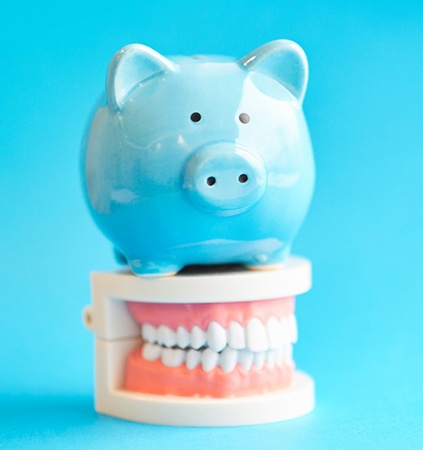
Invisalign lets you keep your confidence while you straighten your smile, but how much does it cost? The truth is, the price of Invisalign in Richmond can vary greatly from patient to patient. Each treatment is tailored to meet the unique goals and needs of the patient, so no two Invisalign journeys will look exactly alike. During your initial consultation, we’ll look at several important factors in order to give you a personalized estimate of the length and cost of your treatment. Until then, read on to learn more important information about the cost of Invisalign.
Factors that Affect the Cost of Invisalign

Several factors will influence the final cost of your Invisalign treatment, such as:
- Case Complexity: The more severe or complex your orthodontic problems are, the more expensive your treatment may be. For example, closing a small gap between the front two teeth will be less expensive than correcting an entire arch of crooked and overlapping teeth.
- Treatment Length: The longer your treatment takes, the more aligners you’ll need, which will inevitably add to the overall cost.
- Your Compliance: If you lose your aligners frequently, break them often, or don’t wear them enough, your treatment may get off track, which would increase its length and cost.
Invisalign VS Smile Direct Club™: Which Costs More?
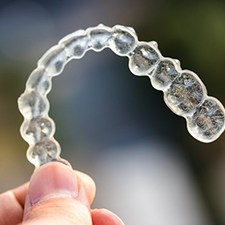
Invisalign is undoubtedly one of the most convenient ways to correct orthodontic issues. However, companies that offer mail-in aligners, like Smile Direct Club™, may sound pretty tempting. However, these do-it-yourself orthodontics can potentially cause a lot more harm than good.
With mail-in aligners, you’ll be in charge of taking impressions yourself, and if they’re not done correctly, the aligners may move your teeth even further out of place. Plus, you won’t have a trained dentist monitoring your situation to ensure your treatment is going as planned. Of course, that also means that if something were to go wrong, you’d have no where to turn except for the customer support email or automated phone line. When you choose to come to us for your Invisalign treatment instead, you can rest easy knowing that you have a highly trained team with you every step of the way to ensure everything goes exactly according to plan. Remember, when it comes to straightening your smile, cheaper is not better!
Does Dental Insurance Cover Invisalign?

This depends on if your specific dental insurance policy covers orthodontic treatments. Not all policies do, and even among those who do, not all cover Invisalign. To find out your coverage, contact your insurance provider. We’ll also be happy to review the details of your plan over the phone or during your initial consultation. Our team will make sure that your benefits are being maximized and your out-of-pocket expenses are being minimized.
Options for Making Invisalign Affordable

Don’t have dental insurance? Not satisfied with your coverage? Not to worry! We want to make achieving a happier, healthier smile as affordable as possible. That’s why we also offer:
- In-House Dental Membership Plan: As an exclusive deal with our practice, you can pay one flat fee for a year of basic dental care and 15% off all other treatments, including Invisalign.
- CareCredit Financing: CareCredit offers low- to no-interest payment plans so you can gradually pay for your Invisalign treatment over several months or even a year in smaller, more manageable payments that fit into your budget.
Living with Invisalign Aligners

You may know what Invisalign aligners look like and some of the benefits of this orthodontic treatment, but what does life with braces actually entail? Since this orthodontic treatment is as discreet and comfortable as it is hassle-free, you might not experience much of a learning curve. Even then, it’s a good idea to familiarize yourself with all of the guidelines so you have a smooth journey to a straighter smile!
Wearing Your Trays
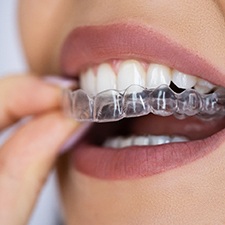
Wearing your aligners for 20-22 hours a day is perhaps the most important Invisalign guideline. After all, if you don’t wear your trays, they won’t work! The best thing to do is only take them out when absolutely necessary and use the Invisalign app to track your wear time. It can also be helpful to set a reminder on your phone so you put your aligners back in right after you’re done eating!
Cleaning Your Aligners
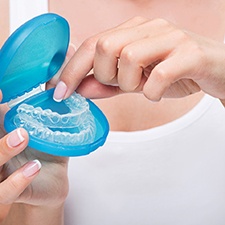
Patients often assume that they need to buy special products in order to keep their aligners clean. That’s not the case! To prevent stubborn stains from surfacing, simply use a soft-bristled toothbrush and some clean, cool water after each meal. Your Invisalign welcome kit will also include some cleaning crystals, which you can use when your trays need a more thorough cleaning. Just make sure to avoid bleach and any other household cleaners!
Eating & Drinking

You’ll be happy to hear that you don’t have to remove raw nuts, tortilla chips, and other crunchy foods from your diet. In fact, you don’t even have to steer clear of coffee! There’s really only one rule when it comes to eating and drinking with Invisalign: you have to remove your aligners (unless it’s water). Not only does this ensure that your trays stay completely clear, but it also ensures they don’t warp, crack, or completely break in half.
Losing or Damaging a Tray
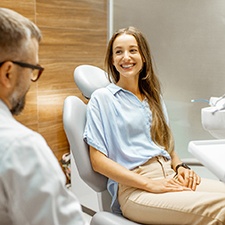
Every minute that you aren’t wearing your trays matters, which is why many patients begin to panic if they can’t find theirs or if they are damaged. In both cases, it’s best to give our Richmond dental team a call. From there, we can determine what the next best steps are, which may be simply moving on to the next step of aligners in the series!
Important note: If you break your aligners, do NOT use superglue, nail glue, or any other household adhesive in an attempt to repair them.
Routine Check-Ins
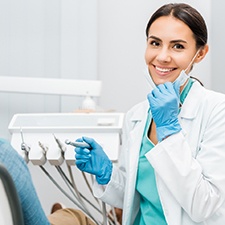
Traditional braces require adjustment appointments every four weeks. With Invisalign, the check-in visits are a bit more spaced out (usually every six to eight weeks). At each one, we will take new scans of your teeth to monitor how your teeth are moving. If everything looks good, then we will send you on your way with your next batch of aligners. If one or more of your teeth aren’t moving as anticipated, then we may need to make a small adjustment to your treatment plan.
Invisalign FAQs
Are you excited to keep your confidence while you straighten your smile with Invisalign in Richmond? This unique orthodontic treatment is very different than traditional metal braces, so it’s natural to have a few questions. While we’ll be more than happy to personally answer all your inquiries during your initial consultation, feel free to take a look at some frequently asked questions we’ve gathered for you below!
Will Straightening My Teeth with Invisalign Hurt?
Traditional metal braces are notorious for their sharp wires and brackets that wreak havoc on soft tissues like the lips, cheeks, and tongue. Since Invisalign aligners are crafted from a single, smooth piece of biocompatible plastic, you can expect a much more comfortable experience! However, moving teeth into a new position will always cause some level of discomfort. While you may experience some soreness for a few days after starting a new set of aligners, it should be short-lived and easily managed with over-the-counter pain relievers and ice packs.
How Long Do I Have to Wear My Invisalign Aligners Every Day?
While the removable nature of Invisalign aligners is one of its most popular benefits, it’s also one of its greatest responsibilities. It will be up to you to keep your treatment on track by wearing your aligners for 20-22 hours every day. If you don’t wear them often enough, your teeth may begin to shift back out of place. This could potentially increase both the timeline and cost of your treatment!
What Foods Can I Eat During My Invisalign Treatment?
Unlike traditional braces that require you to adhere to a diet that doesn’t contain sticky, crunchy, or hard foods, you can eat anything you like during your Invisalign treatment! Simply take your aligners out, enjoy your food, and then give your teeth a quick brush before popping your aligners back into place. However, it’s important to remember that you should always store your aligners in their case when you’re not wearing them. While it may be tempting to wrap them up in a napkin while you eat, it’s all too easy to accidentally leave them behind or throw them away!
Will Wearing Invisalign Aligners Change How I Talk?
At the beginning of your Invisalign treatment, it may sound like you have a slight lisp. This is because the placement of your new aligners blocks some of the areas your mouth uses to make certain sounds. But don’t worry—this won’t last for very long! Your tongue simply needs time to adjust to the presence of your aligners. Typically, the lisp will fade on its own within a week or two. To speed up this process, you can practice speaking aloud and repeating words like “sixty” and “Mississippi.”
Can I Get Invisalign If I’ve Had Metal Braces Before?
Many patients who had traditional braces earlier in life but then neglected to wear their retainer find that their teeth have become crooked again years later. Thankfully, Invisalign is typically a great choice for anyone with slightly to moderately misaligned teeth. We’ll carefully inspect your teeth, jaw, and bite during your consultation to ensure that Invisalign is the most effective solution for your smile.
Will I Need Invisalign Attachments?
In some cases, attachments might be recommended if a patient requires more than just the clear aligners to straighten their teeth. Although not everyone will have attachments for their treatment plan, they can often help with more complex orthodontic cases. Our team will review your situation and determine if you require them depending on the severity of misalignment and how challenging your tooth movement will be. The specific number of attachments that you might receive will also be based on your unique case and may even change throughout your treatment. Sometimes teeth can end up making unexpected shifts or might not move as expected, so we’ll have to remove the attachments off some of your pearly whites and place them on others.
Who is Not Eligible for Invisalign?
Firstly, Invisalign is mostly reserved for patients who have all of their permanent teeth fully developed, meaning kids as young as 13 years old can already be candidates for this treatment. Although the majority of healthy teens and adults can undergo this orthodontic process, there might be some exceptions where someone may not be eligible for it. For instance, a patient’s bite misalignment may be too severe to be fixed with clear aligners alone, meaning they might have to get braces or use other orthodontic methods instead. Those struggling with small, misshapen, or eroded teeth also might not be good candidates until other preliminary dental work is completed. Patients who smoke and aren’t able to quit this habit won’t be eligible since tobacco products can end up staining Invisalign aligners and increase the risk of oral health issues.
Can Invisalign Fix an Overbite?
Minor overbites might be normal, as you typically want to have your upper teeth slightly in front of your bottom row. However, some patients might have their upper arch protruding too far, which can lead to orthodontic issues that impact their bite and comfort. Invisalign can often correct mild to moderate overbites (and other misalignment issues). That said, some overbites might be too severe to be addressed with clear aligners, meaning you might require other orthodontic treatments to fix the problem. During your consultation, our team will walk you through your situation and determine whether Invisalign can effectively address an overbite.
Does Invisalign Give You a Lisp?
Since your mouth won’t be accustomed to your oral appliance right away, you might experience an adjustment period that could affect your speech. A lisp may occur due to improper tongue placement when talking, which makes certain words sound different when said aloud. This isn’t always the case, but it can happen because the aligners are slightly changing the space within your mouth. The good news is that this is usually temporary and only requires time and practice for you to get used to having your Invisalign trays on.


